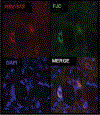Eyeblink tract tracing with two strains of herpes simplex virus 1
- PMID: 35932812
- PMCID: PMC10245079
- DOI: 10.1016/j.brainres.2022.148040
Eyeblink tract tracing with two strains of herpes simplex virus 1
Abstract
Background: Neuroinvasive herpes simplex-1 (HSV-1) isolates including H129 and McIntyre cross at or near synapses labeling higher-order neurons directly connected to infected cells. H129 spreads predominately in the anterograde direction while McIntyre strains spread only in the retrograde direction. However, it is unknown if neurons are functional once infected with derivatives of H129 or McIntyre.
New method: We describe a previously unpublished HSV-1 recombinant derived from H129 (HSV-373) expressing mCherry fluorescent reporters and one new McIntyre recombinant (HSV-780) expressing the mCherry fluorophore and demonstrate how infections affect neuron viability.
Results and comparison with existing methods: Each recombinant virus behaved similarly and spread to the target 4 days post-infection. We tested H129 recombinant infected neurons for neurodegeneration using Fluoro-jade C and found them to be necrotic as a result of viral infection. We performed dual inoculations with both HSV-772 and HSV-780 to identify cells comprising both the anterograde pathway and the retrograde pathway, respectively, of our circuit of study. We examined the presence of postsynaptic marker PSD-95, which plays a role in synaptic plasticity, in HSV-772 infected and in dual-infected rats (HSV-772 and HSV-780). PSD-95 reactivity decreased in HSV-772-infected neurons and dual-infected tissue had no PSD-95 reactivity.
Conclusions: Infection by these new recombinant viruses traced the circuit of interest but functional studies of the cells comprising the pathway were not possible because viral-infected neurons died as a result of necrosis or were stripped of PSD-95 by the time the viral labels reached the target.
Keywords: Eyeblink Conditioning Circuit; H129; McIntyre; Neuroinvasive Viruses; Transsynaptic Tracers.
Copyright © 2022 Elsevier B.V. All rights reserved.
Conflict of interest statement
Declaration of Competing Interest
The authors declare that they have no known competing financial interests or personal relationships that could have appeared to influence the work reported in this paper.
Figures










References
Publication types
MeSH terms
Grants and funding
LinkOut - more resources
Full Text Sources

